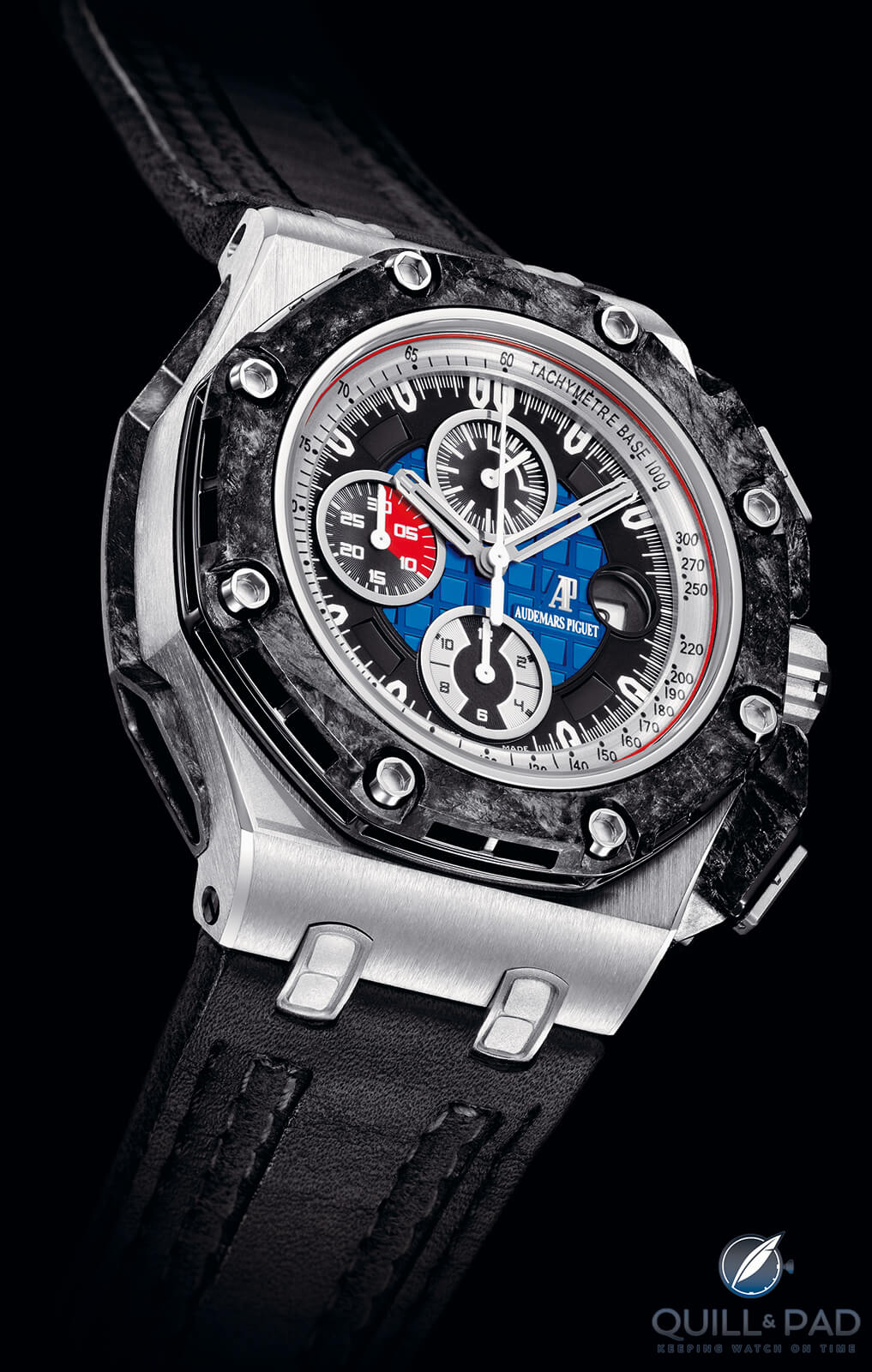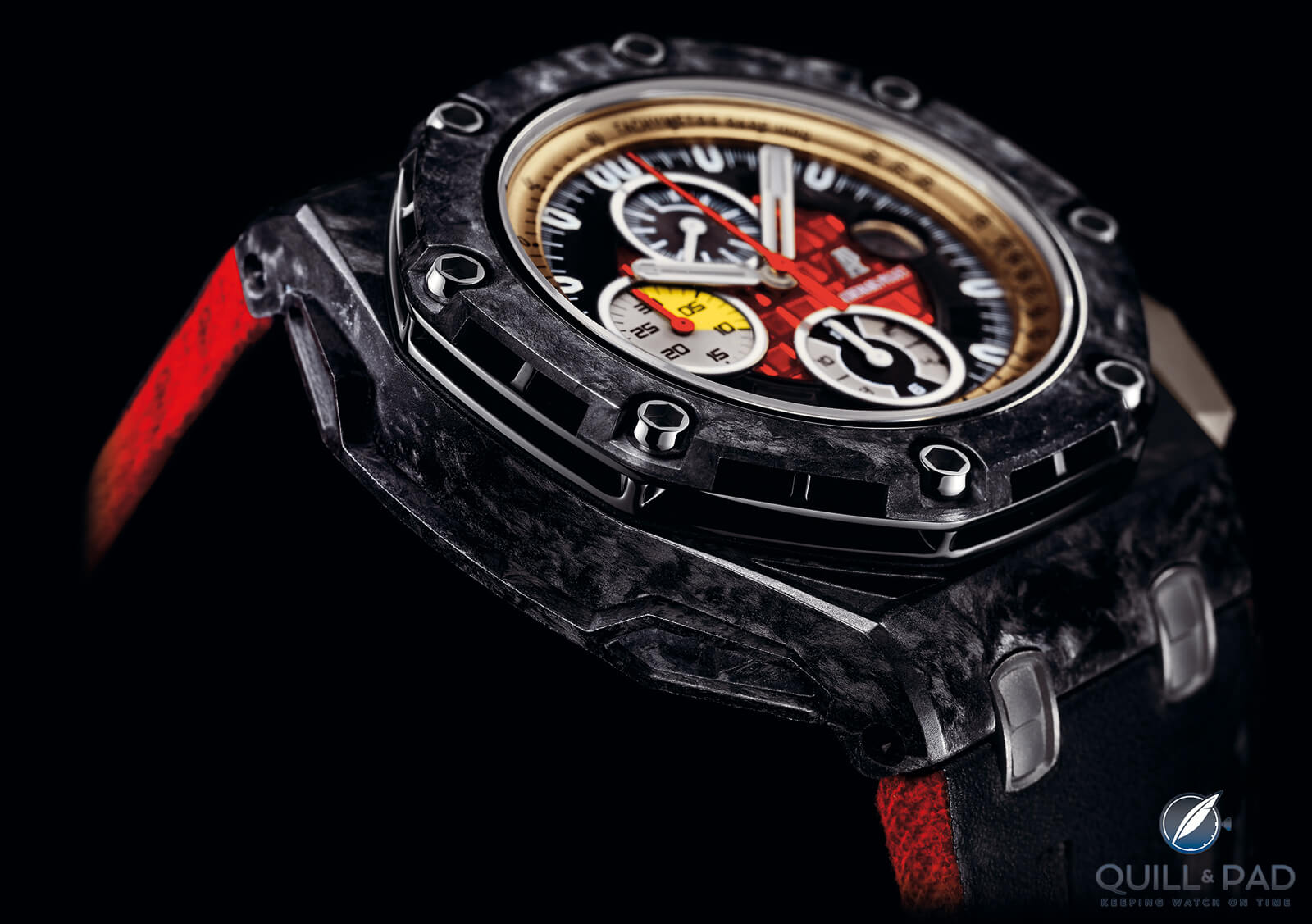Credits: Article and images by Alexey Kutkovoy @ Quill & Pad. See the original article here - https://quillandpad.com/2023/09/04/30th-anniversary-of-the-audemars-piguet-royal-oak-offshore-roo-f1s-high-octane-fairy-tales-of-super-star-racing-drivers/
—————————————————————————————————–
The ROO ‘Singapore Grand Prix’ is an excellent example of a special edition that achieves maximum results with minimal means. Minimal in the sense that the design is based on the original 1993 version of the Royal Oak Offshore, as was the case with the ‘Barrichello I’ watch. The night racing theme was expressed through the aggressive red and black color scheme of the watch: with the forged carbon case ring, the outer ring of the dial with the tachymeter scale, the chronograph counters and the perforated racing leather strap in black; and with the signature méga tapisserie dial, crown, pushers, strap lining and double stitching in red.


2010 Formula One: Royal Oak Offshore ‘Grand Prix’ Chronograph Ref. 26290IO.OO.A001VE.01, 44 mm, forged carbon, ceramic, titanium, limited edition of 1750 pieces
The general theme of the F1 World Championship in the ROO collection does not stop with ROO, created in honor of the Formula 1 race in Singapore. The year 2010, which traditionally began for the brand in January at the SIHH in Geneva, was marked by the launch of the new line of watches with futuristic racing design, which includes three new Royal Oak Offshore ‘Grand Prix’ models. They are not the first futuristically designed watch in the Formula 1-inspired line, and it is easy to find in it many features of the previous ROO F1 models.
The question of which watch was chosen as a prototype in the development of the ROO ‘Grand Prix’ does not arise. Obviously, it is ROO ‘Barrichello II’. I will refrain from a boring enumeration of the relevant features, preferring to draw attention to the differences. There are many, and they are obvious. Let’s start with the dial. For the ‘Barrichello II’, an openworked version of the méga tapisserie motif was developed, while the ROO ‘Grand Prix’ uses a unique inverted relief that will probably remain the only one of its kind, as Audemars Piguet has abandoned the inverted relief in favor of the classic ‘positive’ méga tapisserie relief.


Royal Oak Offshore ‘Grand Prix’ Chronograph with the bezel featuring an unusual hollow design
The Royal Oak Offshore ‘Grand Prix’ has an extremely unusual bezel – nothing like it was made by Audemars Piguet before or since. First, it consisted of an upper part made of carbon and a lower part made of ceramic. Second, the bezel featured lateral channels that look like the ventilation ducts of a formula car – this technical association may have later given rise to the idea for the acoustic ducts on the back of the Royal Oak Concept Supersonnerie Repeater case, which ensure that sound vibrations are effectively diverted away from the watch case to the outside.
The carbon/ceramic bezel is found on all three ‘Grand Prix’ models – made of forged carbon (Ref. 26290IO.OO.A001VE.01, limited edition of 1750 pieces), rose gold (Ref. 26290RO.OO.A001VE.01, 650 pieces) and platinum (Ref. 26290PO.OO.A001VE.01, 75 pieces). The carbon parts (I prefer to call this material a carbon fiber composite), made with the precision forging technique developed by Audemars Piguet, give the ROO ‘Grand Prix’ an appropriate high-tech character. As a bonus, the owner of the watch receives a unique image formed by the carbon fibers on the surfaces of the case, a kind of fingerprint. This image can even be used to identify the watch if necessary.


Audemars Piguet Royal Oak Offshore ‘Grand Prix’ Chronograph, 44 mm, Ref. 26290RO.OO.A001VE.01 in rose gold, ceramic and carbon (limited to 650 pieces) and Ref. 26290PO.OO.A001VE.01 in platinum, ceramic and carbon (limited to 75 pieces)
The protective parts (“square jaw”) for the crown and chronograph pushers of the gold and platinum ROO ‘Grand Prix’ models are also made of carbon, while the pusher guards of the carbon model are made of titanium. The unprecedented ‘wing’ on the left side of the case is also made of carbon. It looks like a counterpart to the protective parts of the crown and chronograph pushers. The triangular cutout in the lower left corner of the case seems to be a complete mystery – it has no visible reason and contradicts the symmetry of the design. This feature and the side ‘wing’ of the case, have never been seen on any other Offshore.


Mysterious triangular cutout in the lower left corner of the gold Royal Oak Offshore ‘Grand Prix’ case
To sum up the review of the Royal Oak Offshore ‘Grand Prix’, the richness of detail, ingenuity and thoughtful finish of this watch stand out even from the diverse racing series of the ROO collection and once again make me admire the talent of Octavio Garcia, the father of modern Offshores and a true master of delicious details.


Jarno Trulli and his Audemars Piguet Royal Oak Offshore ‘Jarno Trulli’ Chronograph
The carbon fiber composite, extensively used in the Royal Oak Offshore ‘Grand Prix’ watches, appeared again in 2010 in an Offshore developed from the original design from 1993 – the Royal Oak Offshore ‘Jarno Trulli’ Chronograph. Unveiled in October at the Japanese Grand Prix, it was the result of a collaboration between Audemars Piguet and Italian Formula One racing driver Jarno Trulli. This driver is clearly not one of the title winners.
He became famous, if only for a resounding victory in the 2004 Monaco Grand Prix, the same race in which Jaguar team driver Christian Klein crashed his race car into the guardrails of a corner and the diamond on the nose of his car, set as an advertisement for the movie “Ocean’s Twelve,” mysteriously disappeared without a trace.
—————————————————————————————————–
Credits: Article and images by Alexey Kutkovoy @ Quill & Pad. See the original article here - https://quillandpad.com/2023/09/04/30th-anniversary-of-the-audemars-piguet-royal-oak-offshore-roo-f1s-high-octane-fairy-tales-of-super-star-racing-drivers/











